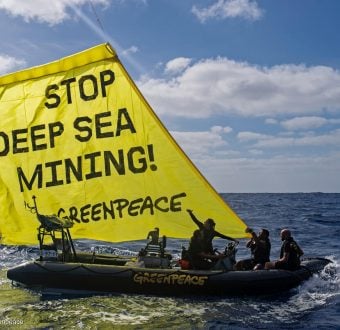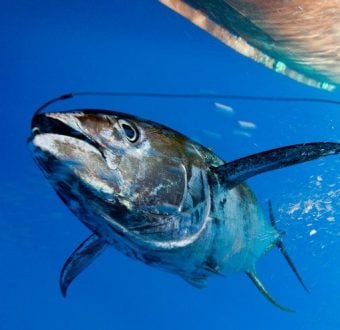Washington, DC – Today Greenpeace launched a global campaign spanning five continents to shrink Coca-Cola’s plastic footprint. Earlier this year, a Greenpeace UK report revealed the scale of plastic pollution from the biggest soft drink company in the world.
Despite its plastic bottles forming a major source of ocean plastic pollution, Coca-Cola failed to disclose key information for Greenpeace’s survey of the top six global soft drink companies released in February, while all of its competitors did.
Greenpeace research has uncovered the company’s incredible use of throwaway plastic – an estimated 3,400 single-use PET bottles a second, as well the company’s failure to meet sustainability targets and absence of a coherent plan to reduce the amount of plastic ending up on beaches, in landfills, and in the sea.
Marine plastic pollution is a growing concern. Studies have shown that microplastics are attractive to some species of fish, causing them to eat more plastic than food and suffer from malnutrition[1]. Microplastics can act as concentrators for other toxins present in seawater, raising concerns about their presence in seafood[2], and larger pieces of plastic can choke marine life such as turtles[3], and are fed by seabirds to their young[4].
“The rate at which Coca-Cola is pumping out single-use plastic bottles is just breath-taking,” said Louise Edge, senior oceans campaigner at Greenpeace UK. “In the absence of full disclosure from Coke, we’ve calculated that it produces over 110 billion throwaway plastic bottles every year – an astounding 3,400 a second – while refusing to take responsibility for its role in the plastic pollution crisis facing our oceans. We’d love Coke to come clean on its plastic footprint and provide detailed breakdowns of what it produces annually.”
- Coca-Cola produces over 110 billion throwaway plastic bottles every year, according to Greenpeace analysis.
- Billions of these bottles are failing to be recovered every year and end up in the environment: on beaches, in landfills, and in the oceans.
- Coke produces over 3,400 throwaway plastic bottles every second.
- Single-use plastic bottles now make up almost 60% of Coke’s global packaging.
- Coke’s use of single-use plastic bottles is actually increasing: up 12% from 2008-15 and up another 2% in the last year (2015-2016).
- From 2008 – 2015, refillable containers fell: down from just under a third (31%) to a quarter (25%) of Coke’s global product packaging, in the same period (2008-15), refillable glass was down by a third (33%) and there was no growth in refillable plastic.
- Coke is failing on recovery & recycling rates:
- Coke set a target in 2013 that its recovery & recycling rates in developed countries would rise to 75% by 2020. Greenpeace analysis of Coke’s available data (2013-2015) shows these rates are actually declining: down from 63% in 2013 to 59% in 2016.
- Coke no longer breaks down its progress on packaging:
- Coke is masking its global packaging mix, making it difficult to measure further backsliding. The company no longer discloses the breakdown of refillable versus single-use packaging in its annual reports and declined to disclose the volume of its refillable bottle sales to Greenpeace.
Louise Edge continued:
“This isn’t just about litter disfiguring our beaches. Scientists estimate that plastic pollution is in up to 90% of seabirds, in sea salt, in drinking water from all over the world, and in seafood. We know that plastic is a serious problem for many varieties of marine life, and now we’re all part of a huge uncontrolled experiment to find out its effects on us.
“But even in the face of new research showing the frightening extent of ocean plastic pollution, the harm it does to ocean ecosystems and its clear role in causing the problem, Coke is producing more and more throwaway plastic.
“Our oceans simply can’t stomach any more plastic. That’s why we’re calling on companies like Coca-Cola to commit to phase out single use plastic bottles, embrace reusable packaging and invest in developing innovative new delivery systems.”
###
Contact:
Perry Wheeler, Greenpeace USA Communications and Outreach Manager, P: 301-675-8766
Graham Thompson, Greenpeace UK Press Office, [email protected] or +44 (0) 7801 212 960
Notes to editors:
=Click here for the full report.
=In February Greenpeace released the first ever comprehensive survey of the plastic footprints and policies of the top six global soft drink companies: http://greenpeace.org.uk/
=Images of ocean plastic pollution can be found here (free to use with credit): http://media.greenpeace.org/
Footnotes
1. http://rspb.
2. http://www.oceanhealthindex.
3. http://news.
4. http://www.huffingtonpost.com.
Methodology
In a recent Greenpeace survey of the world’s largest soft drink corporations, Coca-Cola was the only company that wouldn’t disclose the volume of plastic packaging it puts on the market annually. Coca-Cola said that this was ‘commercially sensitive information’ – even though all of its major competitors disclosed their data. It is however possible to estimate Coca-Cola’s plastic footprint by looking at annual sales figures of certain product lines and their proportion in the company’s overall packaging mix since 2012.
In this case, it’s Coca-Cola’s stated figures of PlantBottle sales and the proportion they form of the company’s global packaging mix from 2012, 2014 and 2015, combined with other data on the percentage PET bottles make of its global packaging included in its annual sustainability reports and disclosed to Greenpeace. Using this method, we estimated that Coca-Cola sells in the region of 108-128 billion plastic bottles per year. We have since been in contact with Coca-Cola who have not disputed this estimate.
Coca-Cola confirmed that in 2016, plastic bottles made up 59% of its packaging mix. We estimate using our previous methodology that this results in an increase of 2% in the number of plastic bottles Coca-Cola produced. We estimate this 2% increase results in a single use plastic bottle output of 110 – 132 billion plastic bottles, but have chosen to use the conservative estimate of 110 billion plastic bottles.

